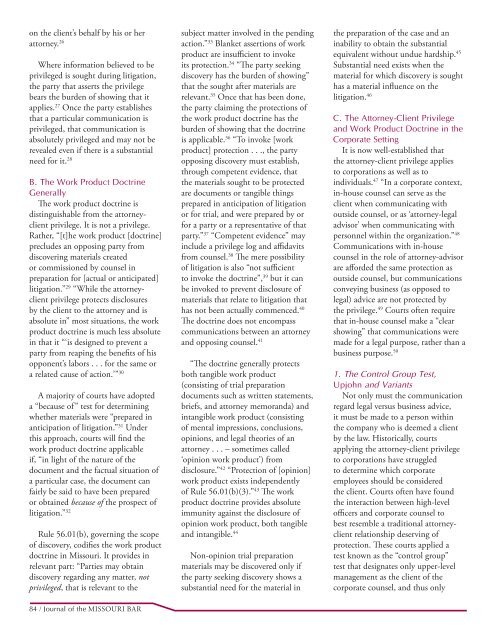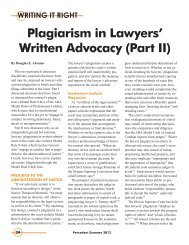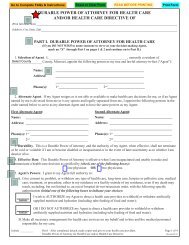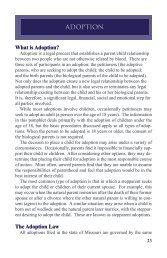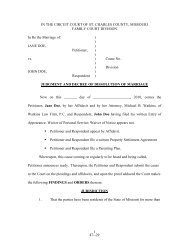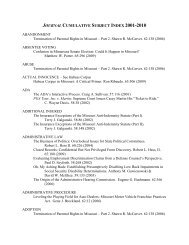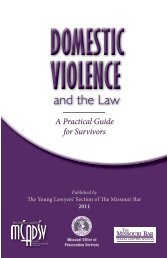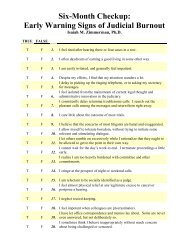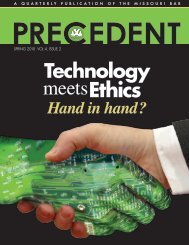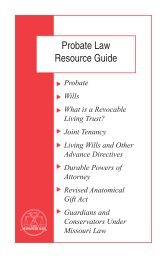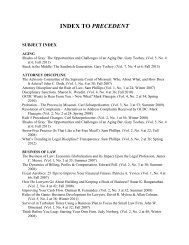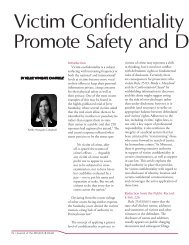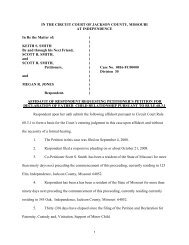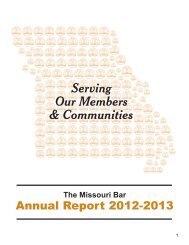An Essential Guide to Attorney-Client Privilege ... - the Missouri Bar
An Essential Guide to Attorney-Client Privilege ... - the Missouri Bar
An Essential Guide to Attorney-Client Privilege ... - the Missouri Bar
- No tags were found...
You also want an ePaper? Increase the reach of your titles
YUMPU automatically turns print PDFs into web optimized ePapers that Google loves.
on <strong>the</strong> client’s behalf by his or herat<strong>to</strong>rney. 26Where information believed <strong>to</strong> beprivileged is sought during litigation,<strong>the</strong> party that asserts <strong>the</strong> privilegebears <strong>the</strong> burden of showing that itapplies. 27 Once <strong>the</strong> party establishesthat a particular communication isprivileged, that communication isabsolutely privileged and may not berevealed even if <strong>the</strong>re is a substantialneed for it. 28B. The Work Product DoctrineGenerallyThe work product doctrine isdistinguishable from <strong>the</strong> at<strong>to</strong>rneyclientprivilege. It is not a privilege.Ra<strong>the</strong>r, “[t]he work product [doctrine]precludes an opposing party fromdiscovering materials createdor commissioned by counsel inpreparation for [actual or anticipated]litigation.” 29 “While <strong>the</strong> at<strong>to</strong>rneyclientprivilege protects disclosuresby <strong>the</strong> client <strong>to</strong> <strong>the</strong> at<strong>to</strong>rney and isabsolute in” most situations, <strong>the</strong> workproduct doctrine is much less absolutein that it “‘is designed <strong>to</strong> prevent aparty from reaping <strong>the</strong> benefits of hisopponent’s labors . . . for <strong>the</strong> same ora related cause of action.’” 30A majority of courts have adopteda “because of” test for determiningwhe<strong>the</strong>r materials were “prepared inanticipation of litigation.” 31 Underthis approach, courts will find <strong>the</strong>work product doctrine applicableif, “in light of <strong>the</strong> nature of <strong>the</strong>document and <strong>the</strong> factual situation ofa particular case, <strong>the</strong> document canfairly be said <strong>to</strong> have been preparedor obtained because of <strong>the</strong> prospect oflitigation.” 32Rule 56.01(b), governing <strong>the</strong> scopeof discovery, codifies <strong>the</strong> work productdoctrine in <strong>Missouri</strong>. It provides inrelevant part: “Parties may obtaindiscovery regarding any matter, notprivileged, that is relevant <strong>to</strong> <strong>the</strong>subject matter involved in <strong>the</strong> pendingaction.” 33 Blanket assertions of workproduct are insufficient <strong>to</strong> invokeits protection. 34 “The party seekingdiscovery has <strong>the</strong> burden of showing”that <strong>the</strong> sought after materials arerelevant. 35 Once that has been done,<strong>the</strong> party claiming <strong>the</strong> protections of<strong>the</strong> work product doctrine has <strong>the</strong>burden of showing that <strong>the</strong> doctrineis applicable. 36 “To invoke [workproduct] protection . . ., <strong>the</strong> partyopposing discovery must establish,through competent evidence, that<strong>the</strong> materials sought <strong>to</strong> be protectedare documents or tangible thingsprepared in anticipation of litigationor for trial, and were prepared by orfor a party or a representative of thatparty.” 37 “Competent evidence” mayinclude a privilege log and affidavitsfrom counsel. 38 The mere possibilityof litigation is also “not sufficient<strong>to</strong> invoke <strong>the</strong> doctrine”, 39 but it canbe invoked <strong>to</strong> prevent disclosure ofmaterials that relate <strong>to</strong> litigation thathas not been actually commenced. 40The doctrine does not encompasscommunications between an at<strong>to</strong>rneyand opposing counsel. 41“The doctrine generally protectsboth tangible work product(consisting of trial preparationdocuments such as written statements,briefs, and at<strong>to</strong>rney memoranda) andintangible work product (consistingof mental impressions, conclusions,opinions, and legal <strong>the</strong>ories of anat<strong>to</strong>rney . . . – sometimes called‘opinion work product’) fromdisclosure.” 42 “Protection of [opinion]work product exists independentlyof Rule 56.01(b)(3).” 43 The workproduct doctrine provides absoluteimmunity against <strong>the</strong> disclosure ofopinion work product, both tangibleand intangible. 44Non-opinion trial preparationmaterials may be discovered only if<strong>the</strong> party seeking discovery shows asubstantial need for <strong>the</strong> material in<strong>the</strong> preparation of <strong>the</strong> case and aninability <strong>to</strong> obtain <strong>the</strong> substantialequivalent without undue hardship. 45Substantial need exists when <strong>the</strong>material for which discovery is soughthas a material influence on <strong>the</strong>litigation. 46C. The At<strong>to</strong>rney-<strong>Client</strong> <strong>Privilege</strong>and Work Product Doctrine in <strong>the</strong>Corporate SettingIt is now well-established that<strong>the</strong> at<strong>to</strong>rney-client privilege applies<strong>to</strong> corporations as well as <strong>to</strong>individuals. 47 “In a corporate context,in-house counsel can serve as <strong>the</strong>client when communicating withoutside counsel, or as ‘at<strong>to</strong>rney-legaladvisor’ when communicating withpersonnel within <strong>the</strong> organization.” 48Communications with in-housecounsel in <strong>the</strong> role of at<strong>to</strong>rney-advisorare afforded <strong>the</strong> same protection asoutside counsel, but communicationsconveying business (as opposed <strong>to</strong>legal) advice are not protected by<strong>the</strong> privilege. 49 Courts often requirethat in-house counsel make a “clearshowing” that communications weremade for a legal purpose, ra<strong>the</strong>r than abusiness purpose. 501. The Control Group Test,Upjohn and VariantsNot only must <strong>the</strong> communicationregard legal versus business advice,it must be made <strong>to</strong> a person within<strong>the</strong> company who is deemed a clientby <strong>the</strong> law. His<strong>to</strong>rically, courtsapplying <strong>the</strong> at<strong>to</strong>rney-client privilege<strong>to</strong> corporations have struggled<strong>to</strong> determine which corporateemployees should be considered<strong>the</strong> client. Courts often have found<strong>the</strong> interaction between high-levelofficers and corporate counsel <strong>to</strong>best resemble a traditional at<strong>to</strong>rneyclientrelationship deserving ofprotection. These courts applied atest known as <strong>the</strong> “control group”test that designates only upper-levelmanagement as <strong>the</strong> client of <strong>the</strong>corporate counsel, and thus only84 / Journal of <strong>the</strong> MISSOURI BAR


